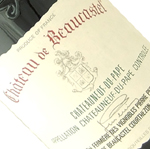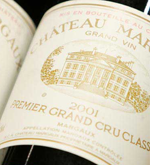Bordeaux 2014 vintage
This report is provided by Corney Barrow LTD
WINTER INTO SPRING
The 2013-14 winter was mild. Despite being the second wettest in half a century, it was also one of the warmest. Spring started with a flourish, with temperatures of 21°C on 7th March, when mid-teens would be more usual. However, it remained cool at night, staving off budding until mid-March.
April continued warm and dry… looking promising. By contrast, May was cool and damp. A brief heat spike brought on flowering, which was then hit by somecoulure (imperfect pollination causing fruit loss) and millerandage (unevenly sized bunches). This particularly affected the early-flowering Merlots and Semillons. The first half of June was scorching, with several days well into the ‘thirties’. Lingering humidity brought the threat of mildew, which was largely staved off by effective canopy management.
‘SUMMER’ – KYRIE ELEISON…
So far, so good. However, as anyone unfortunate enough to have spent their holidays in France will recall, summer was really not worthy of the name. After temperatures of over 35°C on 17th July (the hottest day of the year), summer bade farewell until September. July was cool, drizzly and thoroughly English. The danger of such weather is that vines can ‘decide’ conditions are right for growing foliage rather than berries – a disaster for us wine drinkers. Sure enough, just as veraison (colour change) was beginning, shoots and leaves started to appear, diverting crucial energy from the grapes.
Veraison was a drawn-out affair, continuing well into August, another cool month in the main, but interspersed with some fine spells. The accumulated moisture had by this stage diluted nutrient levels in the soil, leading to uneven-looking bunches – some green berries, some red, some big, some small… An early green harvest was effected to try to restore some order, with de-leafing to get some air into the canopy. To add insult to injury, there was an infestation of rather creepy leaf-eating insects called leafhoppers, requiring yet more vineyard work. Every time one attack was repelled, another front seemed to open up.
AUTUMN – GLORIA!
Just as you are beginning to despair, fear not, for autumn was beautiful. Wine quality aside (as that remains to be seen), if there is a legacy of the 2014 season, it will be the exceptional nature of the late growing season. To avoid accusations of wine merchant hyperbole, I will quote from Bill Blatch’s excellent report for the Union des Grands Crus, in which he calls the period from the end of August until the end of October “the longest Indian summer of all time”. It was the third driest September of the past century, and also the third hottest.
HARVEST
The white grape harvest started in the first week of September, with the Semillons and then Sauvignons, under hot and bone dry skies. Hugely promising for the dry whites.
The Merlots – those powerhouses of the right bank particularly – surged ahead at this point, putting on 3.5% potential alcohol in the first three weeks of September in some cases, before being harvested under largely dry conditions. Pomerol was among the first to start (Petrus picked on 3rd and 4th October), followed by Pessac-Léognan, the Medoc and lastly (unusually), Saint-Emilion, which enjoyed an unprecedented month-long Merlot harvest. Whereas the Medoc was slightly constrained by mild drought pressure (alleviated by some isolated but untroubling showers), the right bank Merlot harvest could afford to be leisurely in the extreme, giving the tannins time to refine.
After a salubrious, sunny intermission, the Cabernets followed. The Medoc started to pick Cabernet Sauvignon first, Lafite and Mouton beginning on 1st October, followed by the right bank Cabernet Franc, which finished in mid-to-late October. It is worth noting that whilst budding was two weeks early, the Cabernets were on average picked one week late, a three-week extended growing season which it is claimed has much benefited the tannin development. By the end of October the reds were safely in.
The final trie (berry selection) in Sauternes was as late as the first week of November, after a rush of noble rot brought on by welcome rain on 9th October.
Sorting has become an art form in Bordeaux, with some estates using two or three intensively-manned sorting tables, in addition to the latest gadget du jour, an optical sorter. These incredible machines analyse each individual berry as it falls, a jet of air blowing anything substandard out of the mix. Such attention to detail is, if not unrivalled these days, certainly impressive, and guarantees the results in the glass will be the best of all possible versions.
OUR HOPES (AND FEARS) – SANCTUS?
We leave to taste later this week. What do we expect? As always, we go with an open mind. Alcohol levels are reportedly on the high side, averaging 13.5-14.5% for the Merlots and 12.5-13.5%+ for the Cabernets. No higher than in the great recent vintages of 2009 and 2010. As long as it is balanced by depth of fruit and tannic structure, alcohol lends body. The proportion of malic to tartaric acidity has been recorded as quite high. No bother, as tart malic acid is easily softened by the malolactic conversion. The whites look set to be excellent, both dry and sweet. It is too early to start the UK trade’s favourite game of vintage comparisons… save to note that 2001 had the brakes applied by a similarly difficult July before enjoying a warm, largely dry autumn. But the ups and downs were more pronounced in 2014. Whereas 2001 was – and continues to be – a gentle, friendly vintage, there is likely to be more tannic rigour in the 2014s. Something along the lines of 1996 then? Watch this space.
Our fears are mostly price-related. The UK (indeed global) wine trade has been absolutely clear about our price expectations and economic realities. It was encouraging to see Latour release its 2003 vintage ex-chateau last week at a sensible price relative to the market. By all accounts it has sold well. As the first release of the season (albeit of a different vintage), let us hope this sets the pace for others. A coincidental exchange rate discount will not be enough – we need to see a clear financial incentive to buy. As recently announced, the Robert Parker era is no more, and there are plenty of other wines we could sell at this time of year. But we are rather fond of these ones.
Guy Seddon, March 2015









